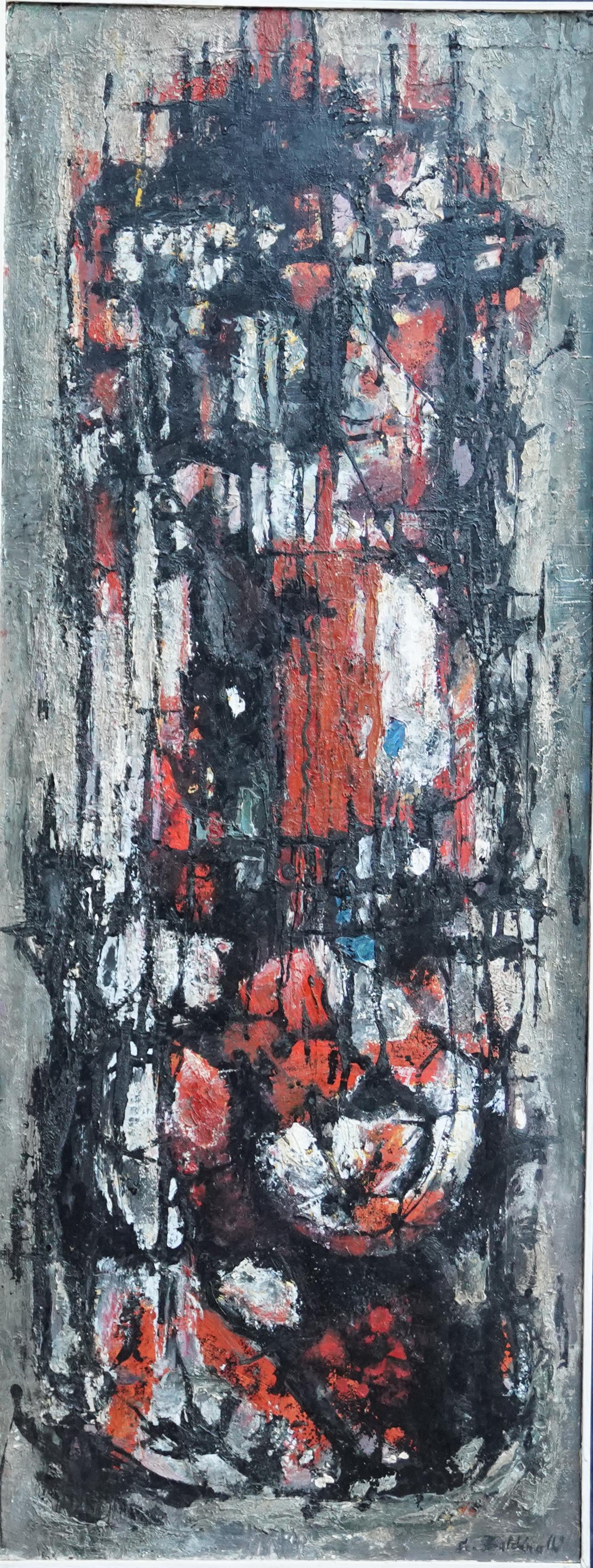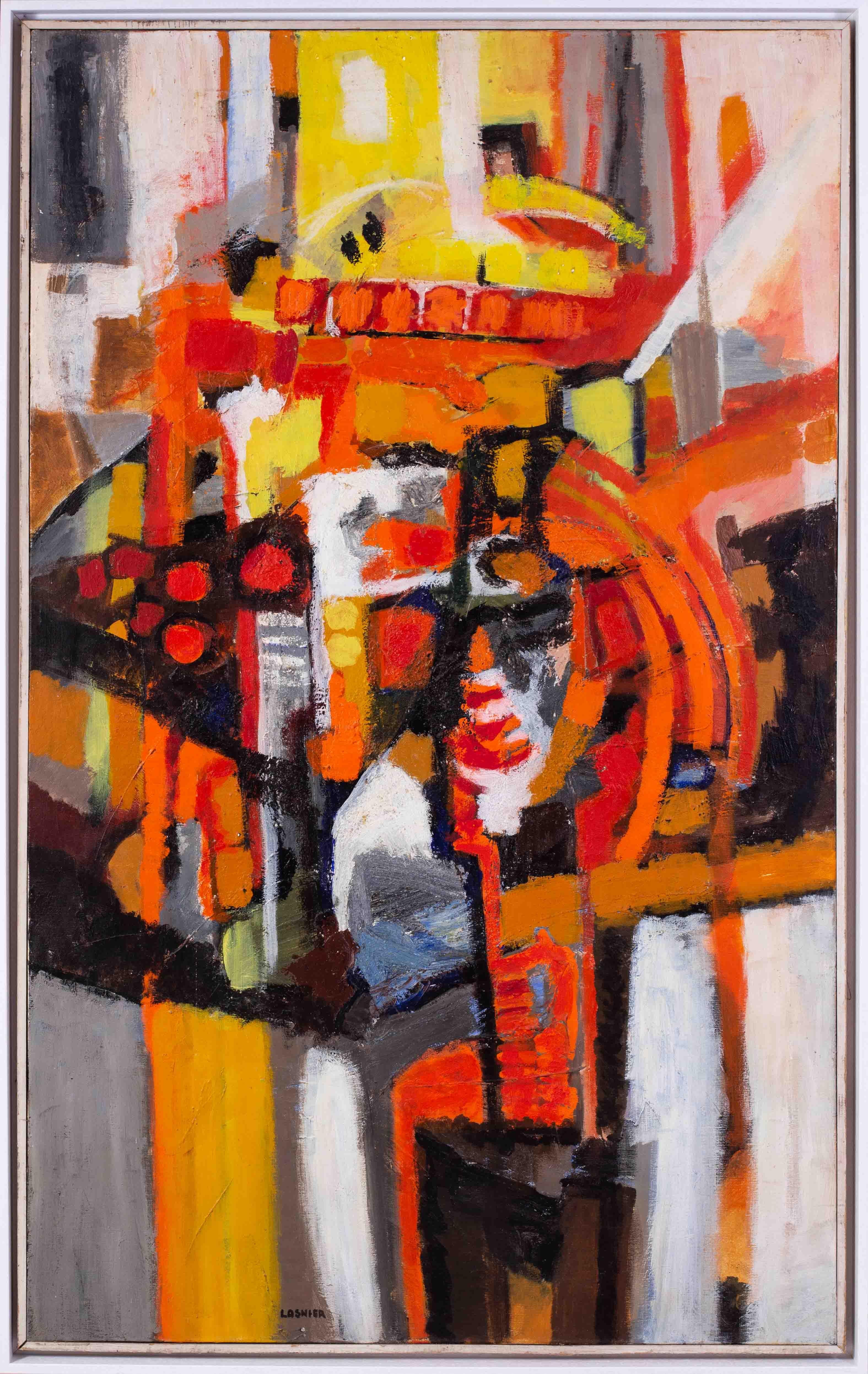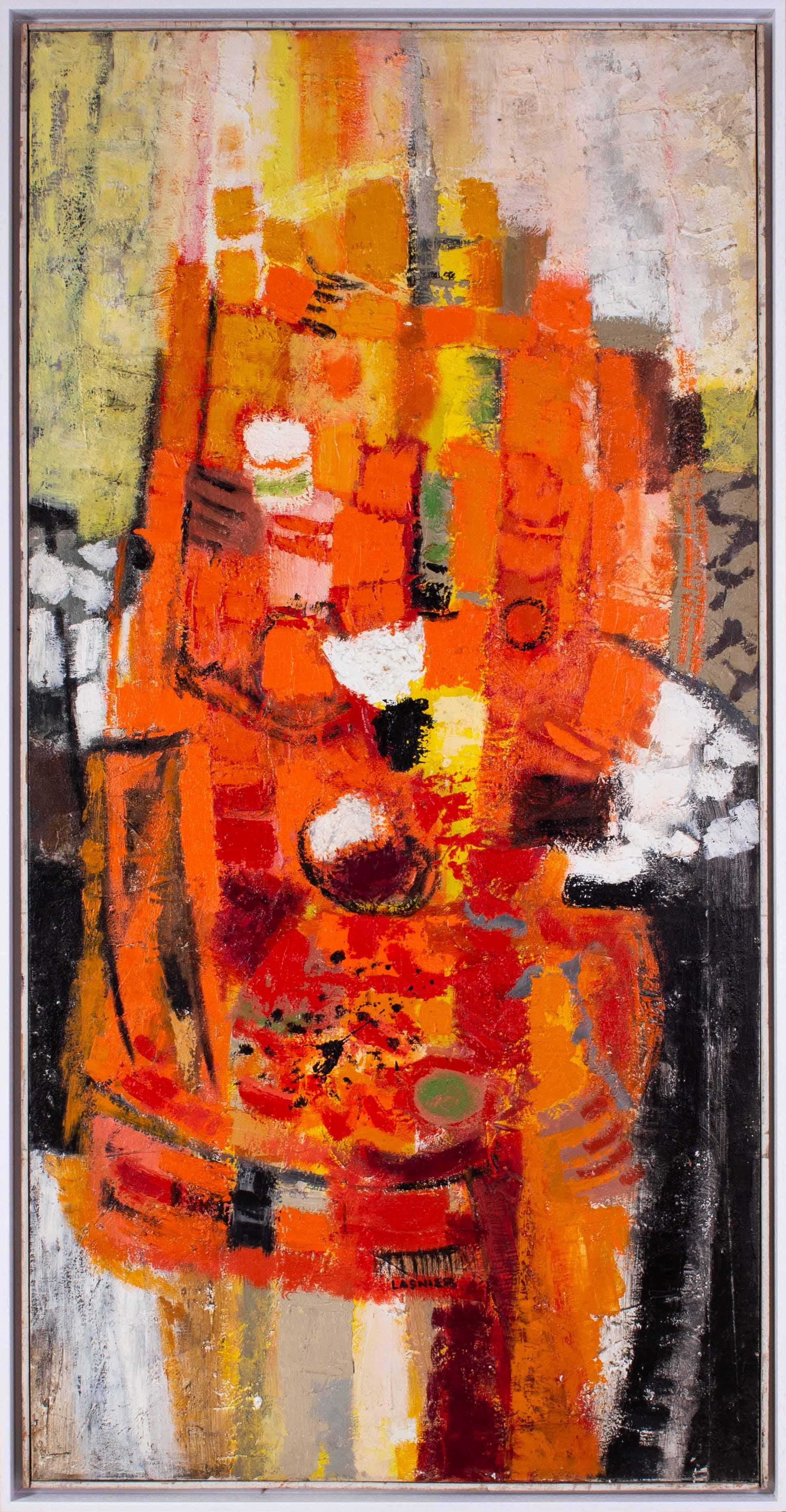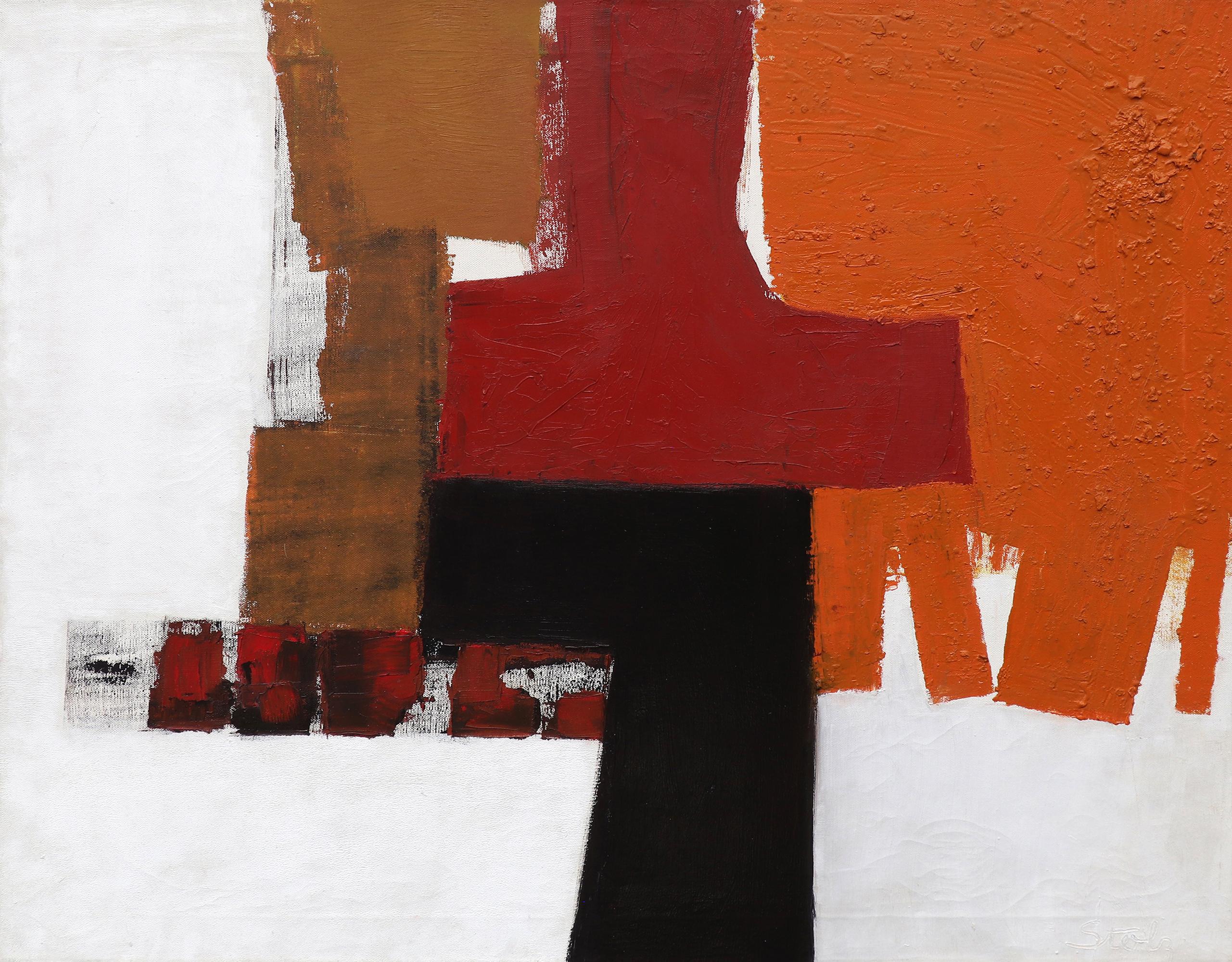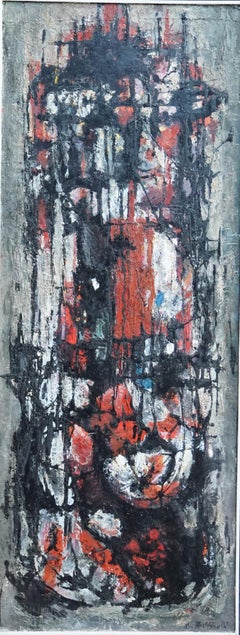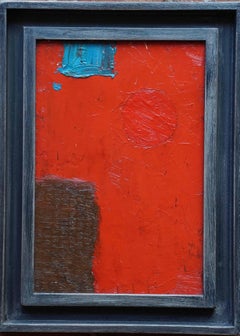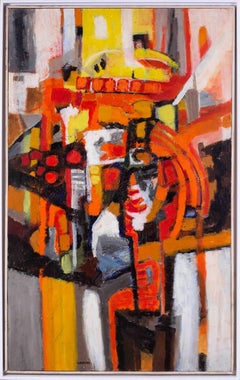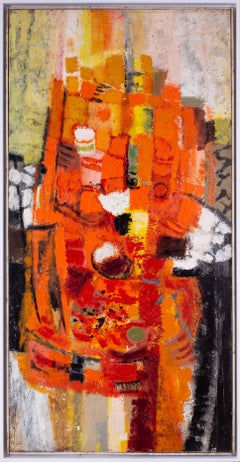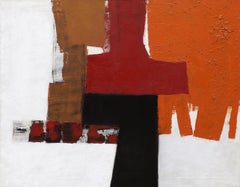Items Similar to Enigma No. 1 - Scottish 1950's Abstract art oil painting orange black
Want more images or videos?
Request additional images or videos from the seller
1 of 19
William GearEnigma No. 1 - Scottish 1950's Abstract art oil painting orange black1954
1954
$11,423.86
£8,400
€9,854.19
CA$15,994.84
A$17,630.68
CHF 9,109.89
MX$210,762.27
NOK 114,601.82
SEK 107,709.39
DKK 73,602.12
About the Item
This superb Scottish abstract oil painting is by noted artist William Gear. It was painted in 1954, entitled Enigma 1 and is an orange geometric shape on a black background that blends into a black surround frame. Painted in blocks there is heavy impasto blobs of red, green and blue down the centre of the orange that almost look like gems. It is very pleasing to the eye and an excellent example of Gear's work from that early period. It has exceptional provenance in that it was exhibited by Gimple Fils Gallery in the fifties.
Unsigned on front, signed titled and dated '54 verso.
Provenance. The family of William Gear.
Gimpel Fils label verso.
Condition. Oil on canvas, image size 22 inches by 15 inches, in good condition.
Frame. Housed in a black surround frame, 26 inches by 19 inches, in good condition.
William Gear (1915-1997). Few British painters have played an active role in the modern abstract movement of post-war Europe. William Gear was the most passionate and committed exception. He continued the tradition of the Edinburgh-Paris axis established by J.D. Fergusson, Samuel Peploe and others, spending vital years between 1947 and 1950 living and working in Paris. Significantly, in recent years, he received the greatest acclaim in France, Germany and the Netherlands. He was born in 1915 in Methil, Fife, into a mining family; the particular landscape of "pitheads, the sea, rocks, castles, trees, storms and poverty" marked his earliest identity with a place and probably remained the most influential to his art. Years later he recalled as a schoolboy visiting the local art gallery in Kirkcaldy and seeing 12 colourful still-lifes by Peploe. Art-history lessons during student years at Edinburgh College of Art, in particular Byzantine classes under David Talbot Rice, also influenced his concern for structure. This had as much to do with the formal language of painting as sheer delight in the medium itself. Gear never missed an opportunity to show people the merits of a well-constructed painting. On a travelling scholarship in 1937, he chose to study with Fernand Leger, described by Gear as "a keystone for me, seldom abstract, rather a degree of abstraction". The Second World War interrupted these formative years and, by 1940, Gear had joined the Royal Corps of Signals. Dispatched to the Middle East, he still had the discipline to paint - mostly works on paper of damaged landscapes - with exhibitions in Jerusalem, Tel Aviv, Cairo as well as Siena and Florence. His naturally robust and tenacious temperament was profoundly affected by visiting Bergen-Belsen, and this certainly influenced the later experiments with the black armature. As the British officer in Celle, working for the Monuments, Fine Arts and Archives Section of the Control Commission, he focused on securing the safety of the Berlin Art Collection in Schloss Celle, and organised an important series of modern art exhibitions, including the rejected work of Karl Otto Gotz. Only a few weeks before his death, this service to "democratic art and artistic freedom" was recognised in Hanover by a unique Leporello Award, appropriately instigated by fellow artists and presented by the Lower Saxony government. Demobbed in 1947, Gear headed for Paris, where he established a one-room studio at 13 Quai des Grands Augustins. This exciting period saw him gravitating towards what he called "the freer, dramatic approach of abstraction lyrique" rather then "the dogmatic hard-edged school of Mondrian and De Stijl". Within a year there were exhibitions at two of the pioneering salons and a first one-man show at the Galerie Arc en Ciel. At the same time inclusion in Cobra shows in Amsterdam and Copenhagen in 1949, alongside Constant, Corneille and Appel, underpinned his affiliation to a reinvigorated form of abstract expressionism. He worked at the time in the fluid medium of opaque water-colour, usually on card with pockets of intense colour on a white or neutral ground. While some pieces were purely abstract, others carried their own suggestion of landscape, or even a form of Celtic figuration. The same year saw an exhibition at the Betty Parsons Gallery in New York, alongside Jackson Pollock. The impact of American abstract expressionism however remained a sore subject, which in conversation was usually dismissed with a curt reminder of what he and others were already painting in Europe. The decision to return to England in 1950 was both personal and practical. Recently married to Charlotte Chertok, and with a baby, he had already secured in 1948 the first of a series of London exhibitions with the Gimpel Fils Gallery. The atmosphere surrounding the Festival of Britain also appeared to offer fresh opportunities. Notoriously, Gear was awarded one of the Festival of Britain Purchase Prizes for Autumn Landscape, a large oil on canvas which took six difficult months to complete. The event produced written questions and answers in the House of Commons and a tirade of abuse from the national press, not to mention a topic for debate on the radio programme Any Questions. While the episode made him a household name, the longer-term effects were, arguably, more detrimental. He chose not to live in London or join fellow abstract artists in St Ives, preferring the independence of a village in Kent between 1953 and 1958. This period saw the continued development of large landscape structures, as well as "side-roads" into sculptural subjects and minimalist colour paintings, which openly acknowledged the influence of Nicolas de Stael. These works have still to be properly exhibited. Mau-Mau (1953), for example, painted for the Contemporary Art Society but at the last minute withdrawn from display at the Tate Gallery, has its first London showing in the current golden jubilee exhibition at the Redfern Gallery. Gear was out of critical favour for most of the 1960s and 1970s. He exhibited more irregularly, despite returning to the use of dark structures broken by selected movements and light-inflected primary colours. While contemporaries questioned his move to Eastbourne as Curator of the Towner Art Gallery (1958-64), Gear's response was to take on the Purchase Committee. He changed the local authority's collection policy from Victorian and local views to securing the foundation of a major collection of post-war British art. His move to Birmingham came with the appointment as Head of the Faculty of Fine Art, Birmingham College of Art, in 1964, a post held until retirement in 1975, by which time he had become increasingly un- interested in the growing bureaucracy surrounding art education. His support and encouragement to artists living in Birmingham however continued with the purchases made for Birmingham Museums and Art Gallery on behalf of the Friends organisation (1987-94) as well as for his own personal collection. Most recently he instigated the idea of a gallery of modern art in Birmingham. Fortunately, the last 15 years have also gone some way to reverse the years of neglect. Gear and Stephen Gilbert (also Scottish) were the only British artists included in the major Cobra 1948-51 exhibition at the Musee d'Art Moderne, Paris, in 1982. The Cobra enthusiast Karel van Stuijvenberg has been a prominent patron and, in 1995, Gear took delight in attending the opening of the Cobra Museum of Modern Art in Amstelveen, near Amsterdam. He was equally proud of his long overdue election to the Royal Academy in 1995, and in the last years relished working with the fluidity and strong colours of oil stick. Tessa Sidey. Exhibited and held by worldwide galleries including The Tate.
- Creator:William Gear (1915-1997, Scottish)
- Creation Year:1954
- Dimensions:Height: 26 in (66.04 cm)Width: 19 in (48.26 cm)Depth: 2 in (5.08 cm)
- Medium:
- Movement & Style:
- Period:
- Condition:
- Gallery Location:Hagley, GB
- Reference Number:1stDibs: LU853117094602
About the Seller
5.0
Platinum Seller
Premium sellers with a 4.7+ rating and 24-hour response times
1stDibs seller since 2018
466 sales on 1stDibs
Typical response time: <1 hour
- ShippingRetrieving quote...Shipping from: Hagley, United Kingdom
- Return Policy
Authenticity Guarantee
In the unlikely event there’s an issue with an item’s authenticity, contact us within 1 year for a full refund. DetailsMoney-Back Guarantee
If your item is not as described, is damaged in transit, or does not arrive, contact us within 7 days for a full refund. Details24-Hour Cancellation
You have a 24-hour grace period in which to reconsider your purchase, with no questions asked.Vetted Professional Sellers
Our world-class sellers must adhere to strict standards for service and quality, maintaining the integrity of our listings.Price-Match Guarantee
If you find that a seller listed the same item for a lower price elsewhere, we’ll match it.Trusted Global Delivery
Our best-in-class carrier network provides specialized shipping options worldwide, including custom delivery.More From This Seller
View AllBlack White Orange Abstract - Italian/South African art fifties oil painting
By Armando Baldinelli
Located in Hagley, England
This superb large abstract oil painting is by Italian born but South African based artist Armando Baldinelli. It was painted circa 1958 after Baldinelli left Italy for South Africa a...
Category
1950s Abstract Abstract Paintings
Materials
Oil
Red on Orange and Green Abstract Landscape - British fifties art oil painting
Located in Hagley, England
This interesting British Abstract oil painting is by artist Peter Field. Painted circa 1955 on canvas and hung as a landscape, the composition is red oblongs on a mostly red and oran...
Category
1950s Abstract Abstract Paintings
Materials
Oil
Orange Abstract - Italian/South African sixties abstract art oil painting
By Armando Baldinelli
Located in Hagley, England
This vibrant abstract oil painting is by Italian born but South African based artist Armando Baldinelli. It was painted circa 1960 after Baldinelli left Italy for South Africa and wa...
Category
1960s Abstract Abstract Paintings
Materials
Oil
Blue Brown Shapes on Red Abstract - British fifties abstract art oil painting
Located in Hagley, England
This interesting British Abstract oil painting is by artist Peter Field. Painted circa 1955 on board, the composition is a blue square and brown oblong on a vivid red background with...
Category
1950s Abstract Abstract Paintings
Materials
Oil
Abstract '83 - Orange Yellow - British 20th century Action art oil painting
By Frank Avray Wilson
Located in Hagley, England
This stunning large Abstract oil on board painting is by noted British artist Frank Avray Wilson. It was painted in 1985 and given to Wilson's good friend and holiday companion, the...
Category
1980s Abstract Abstract Paintings
Materials
Oil
Red Abstract - British 1960 abstract art oil painting
By Peter L. Field
Located in Hagley, England
This vibrant British abstract is by noted artist Peter L Field. Painted circa 1960, the composition in reds has relief sculptural impasto. The red works ...
Category
1960s Abstract Abstract Paintings
Materials
Oil
$3,916 Sale Price
20% Off
You May Also Like
Large French 20th Century abstract oil painting in orange hues by Lasnier
Located in Petworth, West Sussex
Jean Maurice Lasnier (French, 1922 – 2006)
URBAN ORANGE
Signed ‘LASNIER’ (lower right)
Oil on canvas
57.1/2 x 35 in. (146.5 x 88.7cm.)
Category
20th Century Abstract Abstract Paintings
Materials
Canvas, Oil
Large French 1970s Abstract painting in orange hues by Jean-Maurice Lasnier
Located in Petworth, West Sussex
Jean Maurice Lasnier (French, 1922 – 2006)
VILLE SOLAIRE, OCTOBER 1971
Signed ‘LASNIER’ (lower middle)
Oil on canvas
62.1/2 x 31.1/2 in. (158....
Category
20th Century Abstract Abstract Paintings
Materials
Canvas, Oil
Mid Century Abstract Oil Painting in Orange, Red, Brown, White and Black
Located in Denver, CO
Discover a captivating original abstract oil painting on canvas by the renowned artist Henriette "Yetti" Stolz. This untitled masterpiece showcases a rich and dynamic composition, blending deep browns, bold reds, and warm oranges in a way that evokes both intensity and movement. The textured brushstrokes and layered hues create a mesmerizing depth, making this painting a standout piece in any space.
This striking artwork is expertly framed in a new, custom hand-carved wood frame, enhancing its presentation and longevity. The overall framed dimensions are 31 ¼ x 36 ¼ inches, while the unframed image itself measures 34 x 28 inches.
Provenance
This painting comes directly from the estate of the artist...
Category
20th Century Abstract Abstract Paintings
Materials
Canvas, Oil
"Ascendance" - Abstract Expressionist Acrylic Painting in Orange and Black
Located in Carmel, CA
Lee Cox (American, born 1941)
"Ascendance" 2023
Acrylic Paint, Canvas, Stretcher Bars
The artist signed the back of the painting.
In "Ascendance", Lee Cox charts an emotional rise, ...
Category
2010s Abstract Expressionist Abstract Paintings
Materials
Canvas, Acrylic, Stretcher Bars
Mid Century Modern Black, Brown and Orange Abstract
Located in Soquel, CA
Striking mid century modern abstract with black, brown and orange by an unknown artist (American, 20th Century). Signed "Kimball" lower right. Unframed. Image size: 36"H x 36"W.
Category
1960s Abstract Expressionist Abstract Paintings
Materials
Oil, Canvas
Mid-Century Modern American Oil Painting Abstract orange red green brown framed
Located in Buffalo, NY
Anita Johnson
Untitled (Amber Abstraction), c. 1960s
Oil on canvas
Framed dimensions: 10.5 in. H × 12.5 in. W
Original silver-tone metal frame
In this jewel-like composition, Anita ...
Category
Mid-20th Century Abstract Geometric Abstract Paintings
Materials
Oil, Illustration Board
